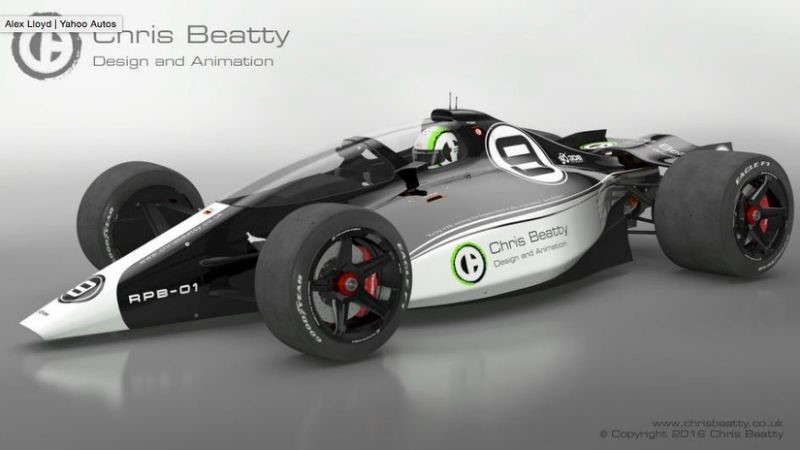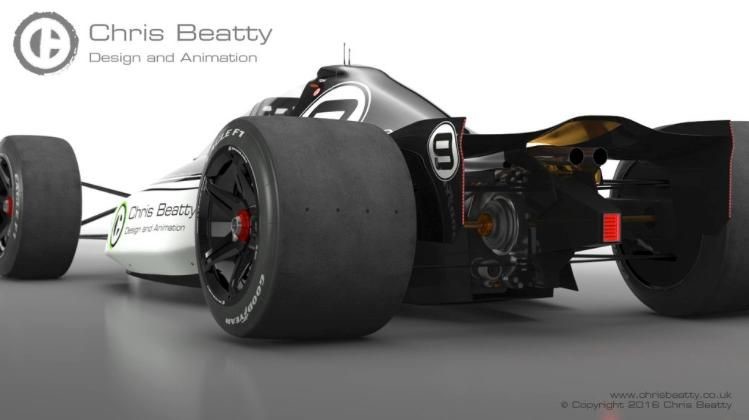Are Current IndyCars Too Quick For Phoenix?
 |
| IndyCar racing would be far better is they were slowed down by removing wings and increasing the dependence on underbody downforce and mechanical grip per this concept car |
After what seemed to be a fast, yet quiet in terms of overtaking 250-lap Phoenix Grand Prix on Saturday night, the first race for the Verizon IndyCar Series at Phoenix International Raceway since 2005, several outside drivers and fans claimed that the on-track action was mild compared to what is seen when the NASCAR Sprint Cup Series competes at the same location on two occasions every year. While at first glance that may be an accurate assertion, there are several things to consider before one sets that claim in stone.
First, the NASCAR stock cars maxed out at 146 miles per hour for the qualifying track record last fall, compared to the 192 MPH lap fired off by Team Penske’s Helio Castroneves to claim the Verizon P1 Award last Friday. Second, keep in mind the stock cars were able to cutoff the dogleg on the backstretch of the one mile, D-shaped oval providing more room to complete passes and run side-by-side.
With the exception of Ed Carpenter Racing’s Josef Newgarden, most drivers due to fear of bottoming out or suffering suspension damage at the extra speeds run, avoided the temptation of going from banking to flat, to immediately back onto the banking, especially considering qualifying speeds in that section were near 200 MPH. Also, while stock cars were able to go side by side through turns one and two and three and four, the IndyCars due to the extra speed avoided the temptation to go two-wide, with fear of going into the grey, the potential cause of Ed Carpenter’s late crash in turn four.
 |
| Note the low, less effective back wing, wide tires and big underbody a perfect equation for side-by-side action |
So what can be done to improve the racing at PIR? One possible option is to apply the low down force package used at Indianapolis, Pocono, and Texas. Champ Car elected to use this setup for Nazareth, St. Louis, and Milwaukee in 1999 and 2000, which slowed the cars down and put more of the handling factor in the hands of the drivers. The adjustments seemed to improve the racing based on the race tapes analyzed from those events. Let’s face it, today’s open wheel cars do not need to be running over 200 miles per hour entering turns one and three at Phoenix, a task that seems even more daunting when side-by-side with another car. While side-by-side action might be difficult, errors made in the corners could allow following drivers to get runs off the corners in order to make passing more accessible.
Although the action may not be have impressive for first-time IndyCar onlookers at Phoenix, an event that only drew an estimated 17,000 spectators on race evening and only received a 0.29 television rating on NBC Sports Network, granted it was in competition to the NCAA Final Four men’s basketball games, the action should improve greatly when the circuit heads to the Indianapolis Motor Speedway next month. On track drama has prevailed recently at IMS, the last four editions of the Greatest Spectacle in Racing have produced the most lead changes ever seen at the Brickyard, including an amazing 68 official swaps in the 2013 event won by the popular Tony Kanaan.
So if one was quick to denounce IndyCar oval track racing this weekend, one ought to suggest the adjustment mentioned above, plus also having one wait to hold judgment until after the 100th running of the Indianapolis 500. Matt Embury/OnPitRoad
